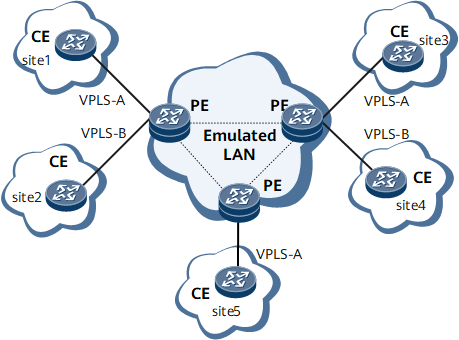Configuring LDP VPLS
Based on MPLS and Ethernet technologies, VPLS is an L2VPN technology that is used to implement point-to-multipoint VPN networking. VPLS is better than both the earlier point-to-point L2VPN services and Layer 3 virtual private network (L3VPN) services requiring carriers to manage the routing information.
Usage Scenario
On the network shown in Figure 1, if PEs support the usage of LDP as VPLS signaling, you can configure LDP VPLS.
PEs are fully meshed using PWs and use split horizon to prevent loops in packet forwarding. A PE forwards packets, including unicast packets, unknown unicast packets, multicast packets, and broadcast packets, received from a PW to only the connected CE rather than to other PEs.
All the PEs need to set up LDP sessions with each other for signaling negotiation of PWs. Packets from CEs are sent to the VPLS network through AC interfaces on PEs.
Pre-configuration Tasks
Before configuring LDP VPLS, complete the following tasks:
Configure interface IP addresses of PEs and Ps and configure IGP routes.
Configure LSR IDs, enable MPLS and MPLS LDP, and establish LDP sessions.
(Optional) Set up remote MPLS LDP sessions if PEs are not directly connected.
Enable MPLS L2VPN on PEs.
Establish tunnels between PEs for data transmission.
- (Optional) Configuring Flow Label-based Load Balancing
- After flow label-based load balancing is configured for an L2VPN, L2VPN services can be classified by flow labels and forwarding paths can be selected based on the flow labels, improving forwarding efficiency.
- Creating a VSI and Configuring LDP Signaling
- Configuring VSI IDs and peer IP addresses are mandatory for LDP VPLS services. VSI IDs are used to identify VSIs in PW signaling negotiation. Perform the following steps on the PEs at both ends of a PW.
- Binding a VSI to an AC Interface
- The view in which a VSI is bound to an Attachment Circuit (AC) interface depends on the type of link between the PE and CE.
- (Optional) Configuring a VSI to Ignore the AC Status
- If the services running on the old network need to switch to the new network, you can configure a VSI to ignore the AC status.
- (Optional) Enabling VPLS LDP Fast Switch
- In LDP FRR scenarios or scenarios where two LDP LSPs work in load-balancing mode, you can enable VPLS LDP fast switch to accelerate unicast convergence.
- (Optional) Configuring BFD for VPLS PW
- After a PW is configured for a VPLS using LDP as signaling, BFD can be configured to monitor the primary PW so that traffic can be immediately switched to the secondary PW in case of a primary PW fault.
- Verifying the LDP VPLS Configuration
- After configuring LDP VPLS, check information about VSIs, remote VSIs, VPLS connections, outbound interfaces of VSI PWs, and tunnel policies applied to VSIs.
